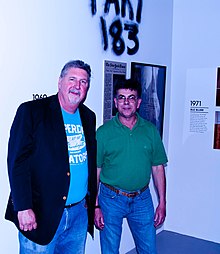
Graffiti is writing or drawings made on a wall or other surface, usually without permission and within public view. Graffiti ranges from simple written "monikers" to elaborate wall paintings, and has existed since ancient times, with examples dating back to ancient Egypt, ancient Greece, and the Roman Empire.

Cool "Disco" Dan was the pseudonym of American graffiti artist Dan Hogg. His standard mark, a particularly styled rendering of his name, was ubiquitous in the Washington metropolitan area, notably along the route of the Washington Metro Red Line.
George Lee Quiñones is a Puerto Rican artist and actor. Quiñones rose to prominence by creating massive New York City subway car graffiti that carried his moniker "LEE". His style is rooted in popular culture and often with political messages.

A number of words and phrases that have come to describe different styles and aspects of graffiti and its subculture. Like other jargon and colloquialisms, some of these terms may vary regionally, taking on different meanings across different cities and countries. The following terminology originates primarily in the United States.

OSGEMEOS are identical twin street artists Otavio Pandolfo and Gustavo Pandolfo. They started painting graffiti in 1987 and their work appears on streets and in galleries across the world.
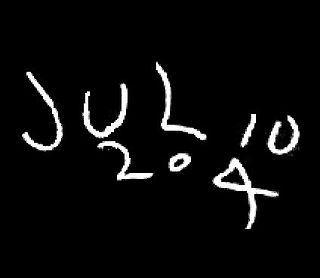
JULIO 204 was a Puerto Rican resident of Inwood who wrote graffiti in his youth. He's usually credited as being the original New York City writer and the inspiration for Taki 183. He started writing his nickname in his neighborhood as early as 1967. He retired when he was arrested for vandalism in the summer of 1970.
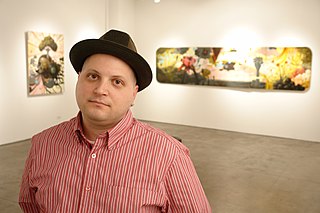
Jonathan LeVine is an American art dealer, instrumental in the proliferation of lowbrow and street art on the East Coast of the United States.

SJK 171, a.k.a.Steve the Greek is a New York City graffiti artist who was active during the late 1960s and 1970s. A native of Washington Heights, he was a founding member of United Graffiti Artists, one of the first professional graffiti collectives.
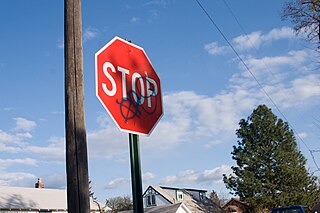
Graffiti are writing or drawings scribbled, scratched, or sprayed illicitly on a wall or other surface in a public place. Graffiti ranges from simple written words to elaborate wall paintings. Graffiti, consisting of the defacement of public spaces and buildings, remains a nuisance issue for cities.
Tim Conlon is an American artist and graffiti writer known for large-scale murals and works on canvas. He was featured as one of several artists in the Smithsonian National Portrait Gallery exhibit, Recognize! Hip Hop and Contemporary Portraiture, which included four large graffiti murals painted by Conlon and collaborator, David Hupp in 2008. This marked the first modern graffiti ever to be in the Smithsonian Institution.

Graffiti in New York City has had a substantial local, national, and international influence.
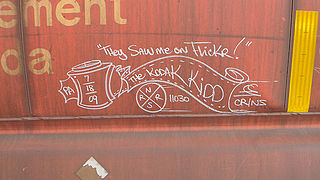
A moniker are a type of graffiti done on the side of a freight car on freight trains. They date back to the late 1800s. Monikers are usually produced with a solid paint stick, industrial crayon, or a lumber crayon. Monikers serve the purpose for a moniker artist to share stories or a moment in time with others.

James Prigoff was an American photographer, author, and lecturer focusing on public murals, graffiti, and spraycan art. He has traveled extensively throughout the world documenting these art forms, and his personal archive of 100,000 slides may well be the most comprehensive of any individual mural and graffiti documentarian.
Art in the Streets was an exhibition held at the Museum of Contemporary Art Los Angeles from April 17 to August 8, 2011. Curated by its then-director Jeffrey Deitch and associate curators Aaron Rose and Roger Gastman, it surveyed the development of graffiti and global street art from the 1970s to the present, covering the cities of New York City, the West Coast, London, and São Paulo with a focus on Los Angeles. It was supposed to travel to the Brooklyn Museum from March 30 to July 8, 2012. The exhibit at the Brooklyn Museum was cancelled because of financial difficulties.

Joel Bevacqua is an American rave DJ, music producer, promoter, and writer known as DJ Deadly Buda. He is also known as the graffiti artist “Buda.” Originally from Pittsburgh, Pennsylvania, he is credited by authors Roger Gastman and Caleb Neelon in their "The History of American Graffiti" as being "Pittsburgh’s first graffiti superstar" and inventor of the “monster rock style” of graffiti lettering. He is also recognized for instigating Pittsburgh's rave scene in 1991. In 2005 part of his techno dance music collection was a notable acquisition of the US Library of Congress: Motion Picture, Broadcasting and Recorded Sound Division.
Roger Gastman is an American art dealer, curator, filmmaker, and publisher who focuses on graffiti and street art.

The Cool S, also known as the Universal S, the Stüssy S, the Super S, the Pointy S, the Savage S, the Basquiat S, the Surfer’s S, and the Graffiti S, is a graffiti sign in popular culture and childlore that is typically doodled on children's notebooks or graffitied on walls. The exact origin of the Cool S is unknown, but it became prevalent around the early 1970s as a part of graffiti culture.
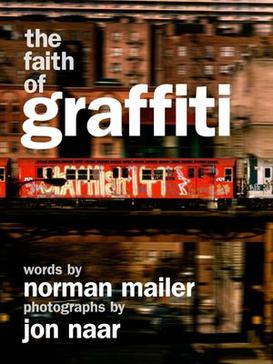
The Faith of Graffiti is a 1974 essay by American novelist and journalist Norman Mailer about New York City's graffiti artists. Mailer's essay appeared in a shorter form in Esquire and as a book with 81 photographs by Jon Naar and design by Mervyn Kurlansky. Through interviews, exploration, and analyses, the essay explores the political and artistic implications of graffiti. The essay was controversial at the time of publication because of its attempt to validate graffiti as an art form by linking it with great artists of the past. Some critics also said Mailer was using the essay as a platform to express his political grievances. Faith grew out of Mailer's existential philosophy of the hip, in which a Hipster is guided by his instincts regardless of consequences or perception, and upholds graffiti as a subversive and healthy check on the status quo. Like several of his other non-fiction narratives, Mailer continued his use of new journalism techniques, adopting a persona, the A-I or "Aesthetic Investigator", to provide both an objective distance from the topic and to engender the text with the creative and critical eye of the novelist.

Tags are one of the primary forms of modern graffiti, along with throw ups and pieces. The act of writing a tag is known as tagging. Tags are often thought of as the simplest form of graffiti art, prioritising legibility and flow and are the form that most artists start with. Tags, perhaps due to their simplicity, are more likely to be considered vandalism than other more elaborate graffiti styles.

Beyond the Streets is a graffiti and street art exhibition and gallery created and curated by Roger Gastman. The first exhibition was held in 2018 in Los Angeles, USA and has since occurred yearly. In 2022, a permanent gallery and store was opened at the location of the original exhibition in LA.
